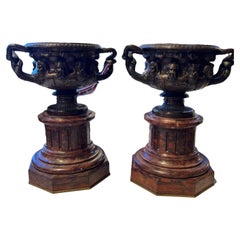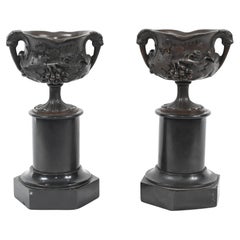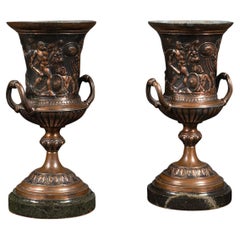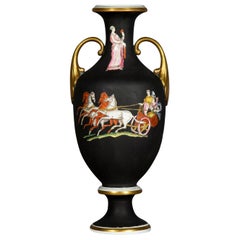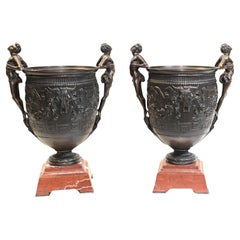Grand Tour Urn
to
24
123
89
206
53
40
32
31
20
11
8
7
6
6
5
5
4
3
3
2
2
2
2
1
1
1
1
1
1
1
1
1
1
Sort By
19th Century Pair of Italian Bronze Grand Tour Urns
Located in Scottsdale, AZ
19th Century Pair of Italian Bronze Grand Tour Urns. Gorgeous design, see photos.
Category
Antique 19th Century Italian Neoclassical Urns
Materials
Marble, Bronze
$2,480 Sale Price
20% Off
H 10.5 in W 6.5 in D 6.5 in
Antique Grand Tour Urn, Italian, Bronze, Posy Vase, Great Exhibition, Victorian
Located in Hele, Devon, GB
This is an antique Grand Tour urn. An Italian, bronze table top posy vase in the Great Exhibition
Category
Antique Mid-19th Century Italian Grand Tour Urns
Materials
Bronze
$1,652
H 8.27 in Dm 5.52 in
Pair Bronze Grand Tour Urns on Stands Marble Pedestal 1880
Located in Potters Bar, GB
You are viewing a refined pair of Italian bronze Grand Tour urns
Classic campana form and stand on
Category
Antique 1880s Urns
Materials
Marble, Bronze
Fine Alabaster Grand Tour Urn
Located in Queens, NY
Italian Neo-Classic Fine Alabaster Grand Tour (19th Century) Urn with carved floral details and
Category
Antique 19th Century Italian Neoclassical Urns
Materials
Alabaster
Pair of Gilt Bronze Grand Tour Urns on Marble Bases
Located in Hudson, NY
A pair of gilt bronze Grand Tour urns mounted on marble bases.
Category
Antique 19th Century French Vases
Materials
Marble, Bronze, Ormolu
Pair, Antique Grand Tour Urns, Italian, Decorative Vase, Roman Taste, Victorian
Located in Hele, Devon, GB
This is a pair of antique Grand Tour urns. An Italian, bronzed decorative vase with Ancient Roman
Category
Antique Mid-19th Century British Vases
Materials
Metal
$2,802 / set
H 11.03 in W 5.71 in D 5.32 in
Early 19th Century Bronze French Grand Tour Urns (Pair)
Located in Louisville, KY
This pair of early 19th century Grand Tour Period bronze gilt volute krater urns on stone bases are
Category
Antique Early 19th Century French Grand Tour Urns
Materials
Stone, Slate, Bronze
19th Century Grand Tour Urn Vase
Located in Richmond, London
A charming Grand Tour style porcelain vase, matte black ground with polychrome decorations in
Category
Antique Mid-19th Century English Neoclassical Revival Vases
Materials
Porcelain
Pair Bronze Campana Urns Grand Tour Classical Barebedienne
Located in Potters Bar, GB
You are viewing a gorgeous pair of classical Grand Tour urns in bronze
Classic campana form flanked
Category
Vintage 1980s Urns
Materials
Bronze
Pair Bronze Urns Cherub Bacchus Italian Grand Tour Campana 1880
Located in Potters Bar, GB
grape
These are a fabulous, high collectable pair of Grand Tour urns
The urns are also mounted with
Category
Antique 1880s Urns
Materials
Bronze
Early 19th Century Bronze Campana Urn
Located in West Palm Beach, FL
Grand Tour urn, of bronze, with a gilt and patented finish showing natural wear, having a column
Category
Antique Late 19th Century European Neoclassical Urns
Materials
Bronze
Antique Pair French Grand Tour Silvered Bronze Pedestal Urns 19th Century
Located in London, GB
This is a remarkable pair of antique French silvered bronze and marble pedestal Grand Tour Urns
Category
Antique 1860s French Urns
Materials
Marble, Bronze
$2,145 / set
H 9.06 in W 6.7 in D 6.7 in
Antique Grand Tour Marble Campagna Pedestal Urn
Located in Wormelow, Herefordshire
An antique early 19th century marble campagna pedestal urn in the Grand Tour manner.
This urns
Category
Antique Early 19th Century English Grand Tour Urns
Materials
Marble, Serpentine
Grand Tour Lapis Lazuli and Marble Urn Vase
Located in Madrid, ES
A Grand Tour vase or urn in white marble with lapis lazuli decoration at the base and a ring around
Category
Antique Late 19th Century Italian Grand Tour Urns
Materials
Lapis Lazuli, Marble
Grand Tour Italian Neoclassical Patinated Bronze Urn Warwick Vase
Located in Hopewell, NJ
Stunning Grand Tour neoclassical urn or cachepot having fancy decoration on the outside and gilded
Category
Antique Late 19th Century Italian Grand Tour Urns
Materials
Bronze
French 19th Century Grand Tour Period Patinated Bronze Urn
Located in West Palm Beach, FL
A handsome French 19th century Grand Tour period patinated bronze urn. The urn is raised by a
Category
Antique 19th Century French Grand Tour Urns
Materials
Bronze
French 19th Century Grand Tour Period Bronze and Marble Urn
Located in West Palm Beach, FL
A handsome French 19th century Grand Tour period patinated bronze and Vert de Patricia marble urn
Category
Antique 19th Century French Grand Tour Urns
Materials
Bronze
Italian 19th century Grand Tour/Neo-Classical st Green Serpentine marble and urn
Located in West Palm Beach, FL
A very handsome and impressive Italian 19th century Grand Tour/Neo-Classical st. Green Serpentine
Category
Antique 19th Century Italian Grand Tour Urns
Materials
Marble, Serpentine, Ormolu
$17,800
H 13 in W 16 in D 14.5 in
Pair of 19th Century Italian Neo-classic Rosso Antico & Carrara Marble
Located in Queens, NY
Pair of 19th Century Italian Neo-classic Rosso Antico & Carrara Marble Grand Tour Urns
Category
Antique 19th Century Italian Neoclassical Planters and Jardinieres
Materials
Marble
$16,500 / set
H 22 in W 16 in D 16 in
Vintage Neo Classical Urn, Continental, Decorative Ornament, Grand Tour, C.1930
Located in Hele, Devon, GB
This is a vintage neo-classical urn. A Continental, Bakelite decorative ornament in Grand Tour
Category
Vintage 1930s Italian Grand Tour Urns
Materials
Bakelite
$1,446
H 15.16 in W 8.86 in D 7.68 in
Vintage Boho Grand Tour Lidded Urn
Located in West Palm Beach, FL
Command attention with this opulent vintage lidded urn, a Grand Tour-style masterpiece blending
Category
Late 20th Century American Hollywood Regency Urns
Materials
Metal
Antique Pair Grand Tour Borghese Bronze & Siena Marble Campana Urns 19th Century
Located in London, GB
A superb antique pair of Grand Tour bronze and Siena marble Borghese Campana urns, circa 1870 in
Category
Antique 1870s Grand Tour Urns
Materials
Marble, Bronze
$3,044 / set
H 13 in W 5.12 in D 4.34 in
Grand Tour Bronze Volute Krater / Vase / Urn by Benedetto Boschetti , C. 1840
By Benedetto Boschetti
Located in Kennesaw, GA
pieces completed and intended for the wealthy gentlemen who took the “Grand Tour” before settling down
Category
Antique Early 19th Century Italian Grand Tour Urns
Materials
Marble, Bronze
$1,421 Sale Price
43% Off
H 11.5 in W 6.75 in D 4.5 in
Grand Tour Cinerarium - 18th century
Located in Bruxelles, BE
. The urn is a display of small souvenir-tokens collected on the Grand Tour of a distinguished gentleman
Category
Antique 18th Century Italian Grand Tour Urns
Materials
Limestone, Marble
Very Good 19th Century Grand Tour Bronze Urn
Located in Hudson, NY
A finely cast and patinated bronze urn decorated in high relief with classical figures and reeded
Category
Antique 19th Century French Urns
Materials
Bronze
19th C. Italian Grand Tour Carrara Marble Double-Handled Urn on Lion's Paw Base
Located in New York, NY
A 19th Century Italian Grand Tour Hand-Carved and Hand-Polished Carrara Marble Double-Handled Urn
Category
Antique 1820s Italian Grand Tour Urns
Materials
Carrara Marble
$28,800
H 33.5 in W 17.5 in D 18 in
Antique French Grand Tour Bronze & Ormolu Urn, 19th Century
Located in London, GB
This is a beautiful antique French Grand Tour dark patinated bronze and ormolu urn with ormolu
Category
Antique 1850s French Urns
Materials
Bronze, Ormolu
Pair Monumental Carved Italian Urns Campana Grand Tour Planters
Located in Potters Bar, GB
You are viewing a gorgeous pair of large carved Italian urns of Campana form
Good size at over
Category
Vintage 1980s Urns
Materials
Wood
Pair of Small Early 19th Century Grand Tour Bronze Urns
Located in Worcester, GB
Pair of Small Early 19th Century Grand Tour Bronze Urns
A decorative and finely cast pair of small
Category
Antique Early 19th Century European Urns
Materials
Bronze
Antique 1920’s Grand Tour Italian Venice Majolica Vase
Located in New Orleans, LA
An antique, grand tour, Italian hand painted and transfer ware majolica handled vase with panels
Category
Vintage 1920s Italian Grand Tour Urns
Materials
Majolica
$300 Sale Price
79% Off
H 12.5 in W 7 in D 4.75 in
19th Century Neoclassical Gilt Bronze Grand Tour Mounted Urns, a Pair
Located in Atlanta, GA
grand tour objects and what makes it better? A PAIR!.
Category
Antique 19th Century Urns
Materials
Bronze
$3,160 Sale Price / set
20% Off
H 10.75 in W 4.125 in D 3.75 in
Antique Pair French Grand Tour Neo Classical Bronze Urns 19th C
Located in London, GB
This superb pair of French Neo Classical Grand Tour bronze urns are most elaborate and finely
Category
Antique 1870s Urns
Materials
Bronze
$2,075 / set
H 9.45 in W 5.91 in D 3.94 in
pair of French 19th century Grand Tour Period Louis XVI st.
Located in West Palm Beach, FL
A handsome pair of French 19th century Grand Tour Period Louis XVI st. Sienna marble, Ormolu and
Category
Antique 19th Century French Grand Tour Urns
Materials
Bronze, Ormolu
$17,800 / set
H 12.5 in W 12.75 in D 8.75 in
Pair of Grand Tour Bronze Two-Handled Urns on Later Wooden Bases
Located in Worcester, GB
Pair of Grand Tour Bronze Two-Handled Urns on Later Wooden Bases
Circa 1900
A decorative pair of
Category
Early 20th Century European Urns
Materials
Bronze
$1,038 / set
H 9.45 in W 6.7 in D 5.12 in
Pair of Italian 19th Century Grand Tour Period Imperial Porphyry Tazzas
Located in West Palm Beach, FL
An extremely elegant pair of Italian 19th century Neo-Classical st. Grand Tour period Imperial
Category
Antique 19th Century Italian Grand Tour Urns
Materials
Porphyry
$17,800 / set
H 9 in W 4.75 in D 4.75 in
PAIR OF ANTIQUE 1870 GRAND TOUR BRONZE MARBLE CLODION BACCHANALIA CASSOLETTEs
Located in West Sussex, Pulborough
pair of 1870 Grand Tour Bronze, Gilt Bronze and Marble Bacchahalia Cassolettes after Cloudio
A very
Category
Antique 1870s Italian Grand Tour Urns
Materials
Marble, Bronze
$8,234 / set
H 13.59 in W 7.09 in D 5.32 in
19th Century Grand Tour Bronze Model of the Medici Vase, or Urn
Located in Pittsburgh, PA
This Grand Tour bronze model of the Medici vase is beautifully cast and patinated. It features a
Category
Antique Late 19th Century Italian Greco Roman Urns
Materials
Bronze
A Pair of Grand Tour Bronze Tazzas on Sienna Marble Plinths
Located in Dallas, TX
A pair of Grand Tour bronze tazzas raised on stepped sienna marble plinths and mounted on sienna
Category
Antique 19th Century Italian Grand Tour Urns
Materials
Siena Marble, Bronze
$2,950 / set
H 10.25 in W 5.25 in D 5.25 in
Antique French Grand Tour Ormolu Bronze Dore Marble Urn Vase Centerpiece 19thC
By Claude Michel Clodion
Located in Dublin, Ireland
Superb Example of French lidded grand tour ormolu & bronze cast heavy duty model of a two handled
Category
Antique Early 19th Century French Regency Urns
Materials
Siena Marble, Bronze, Ormolu
$2,238
H 14.5 in W 8 in D 5.75 in
Antique Pair French Roman Bronze Townley Urns Vases Black Marble Grand Tour 19Ct
Located in Dublin, Ireland
Stunning Pair of Grand Tour French Heavy Gauge Patinated Bronze Townley Urns of compact proportions
Category
Antique 19th Century French Early Victorian Urns
Materials
Belgian Black Marble, Bronze
$1,163 / set
H 9 in W 4.5 in D 4.5 in
Antique Pair Large 16inch Grand Tour Gilt Bronze Campana Urns Early 20th Century
Located in London, GB
A stunning large antique pair of Italian ormolu mounted campana urns raised on polished granite
Category
Vintage 1920s Urns
Materials
Ormolu
$3,113 / set
H 16.15 in W 7.09 in D 7.09 in
Antique Pair of Grand Tour Borghese or Medici Bronze Campana Urns Vases Marble
By Claude Michel Clodion
Located in Dublin, Ireland
Impressive Pair of Grand Tour Twin Handle Patinated Bronze Medici Urns of Campagne outline, of
Category
Antique 19th Century French Regency Urns
Materials
Siena Marble, Ormolu, Bronze
$1,999 / set
H 13.5 in W 9.5 in D 5 in
Pair French Grand Tour Ormolu Bronze Dore Statutory Marble Tazza Urns Vases 19Ct
By Claude Michel Clodion
Located in Dublin, Ireland
Marble Grand Tour Twin Handle Tazza of large and heavy proportions
First quarter of the Nineteenth
Category
Antique Early 19th Century French Regency Urns
Materials
Marble, Bronze, Ormolu
$1,522 / set
H 10.5 in W 7 in D 4.75 in
Pair of Large Neoclassical Urns
Located in New York, NY
Pair of large neoclassical urns. Grand tour patinated copper craters after the antique with swan
Category
Antique Early 19th Century Italian Grand Tour Urns
Materials
Copper
Late 19th Century Grand Tour Bronze Albani Vase
Located in Pease pottage, West Sussex
A Grand Tour Bronze Reduction of the Albani Vase Finely Crafted version of the famous classical
Category
Antique Late 19th Century Italian Urns
Materials
Bronze
Pair of Antique Bronze Grand Tour Townley Vases
Located in Wormelow, Herefordshire
A matching pair of 19th century bronze Grand Tour scale models of the Townley Vase, after the
Category
Antique Mid-19th Century French Neoclassical Urns
Materials
Metal, Bronze
Vintage Grad Tour Gilt Tipped Porcelain Urns - A Pair
Located in West Palm Beach, FL
Elevate your interior with this exquisite pair of vintage Grand Tour gilt-tipped porcelain urns
Category
Antique Late 19th Century French Neoclassical Urns
Materials
Porcelain, Paint
$1,320 Sale Price / set
20% Off
H 15.5 in W 7.25 in D 5.25 in
Large Italian Terra Cotta 'Grand Tour' Amphora c 1820
Located in Kastrup, DK
Rare large classicist 'Grand Tour' amphora in original untouched condition.
Made of terracotta with
Category
Antique Early 19th Century Italian Classical Roman Urns
Materials
Terracotta, Wood
Decorative Orthoceras Fossil Marble Urn
Located in Wormelow, Herefordshire
A very rare and unusual early 20th century decorative fossil marble lidded urn, ex. private
Category
Early 20th Century Grand Tour Urns
Materials
Natural Fiber
Antique Pair French Grand Tour Bronze & Siena Marble Tazze 19th Century
Located in London, GB
A superb antique pair of French Grand Tour bronze and Siena marble mounted tazze, Circa 1870 in
Category
Antique 1870s Urns
Materials
Marble, Bronze
$2,837 / set
H 11.82 in W 9.06 in D 7.09 in
19th Century (early) Pair French Bronze Urns
Located in Scottsdale, AZ
19th Century (early) Pair French Bronze Urns. Beautiful pair purchased in France. Age appropriate
Category
Antique 19th Century French Grand Tour Urns
Materials
Bronze
Pair of Cabinet Size Roman Classical Urns or Vases
Located in Rochester, NY
Pair of Roman classical two handled urns. Patinated cast iron. Mid 19th century grand tour.
Category
Antique 19th Century European Grand Tour Urns
Materials
Iron
French 19th Century Grand Tour Period Patinated Bronze, Marble and Ormolu Tazza
Located in West Palm Beach, FL
A handsome and large scale French 19th century Grand Tour period patinated bronze, marble and
Category
Antique 19th Century French Urns
Materials
Marble, Bronze, Ormolu
$15,300
H 8.5 in W 13.5 in D 13.5 in
A Pair of Italian Regency Tole-Peinte Chestnut Urns
Located in Charleston, SC
Regency style chestnut urns with oval painted foliage on both sides. Red painted flourishes and accents
Category
Early 20th Century Italian Grand Tour Urns
Materials
Metal
Eugene Cornu, Large Marble and Ormolu Urn, 19th Century
By Eugène Cornu
Located in Brighton, Sussex
A very impressive 19th century veined grey marble lidded urn with wonderful gilded ormolu classical
Category
Antique 19th Century French Grand Tour Urns
Materials
Marble, Ormolu
Large Pair of Early 19th Century French Grand Tour Bronze and Siena Marble Tazza
Located in Benington, Herts
A Fine and Decorative Pair of French Grand Tour Bronze and Siena Marble Tazzas of Large Scale
Category
Antique 1820s French Urns
Materials
Marble, Bronze
$4,774 / set
H 11.82 in W 9.06 in D 9.06 in
A Fine Pair of Early 19th Century French Grand Tour Bronze & Siena Marble Tazzas
Located in Benington, Herts
A Fine Pair of Early 19th Century French Grand Tour Bronze and Siena Marble Tazzas of Interesting
Category
Antique 1830s French Urns
Materials
Siena Marble, Bronze
$3,736 / set
H 9.5 in W 7 in D 7 in
Grand Tour Marble and Bronze Tazza Urn Centrepiece
Located in Newark, England
Sarrancolin Marble Tazza Urn. The Grand Tour Tazza Urn of typical form composed from Sarrancolin marble and
Category
Antique Late 19th Century French Grand Tour Centerpieces
Materials
Marble, Bronze
- 1
Get Updated with New Arrivals
Save "Grand Tour Urn", and we’ll notify you when there are new listings in this category.
Grand Tour Urn For Sale on 1stDibs
At 1stDibs, there are many versions of the ideal grand tour urn for your home. Frequently made of metal, bronze and stone, every grand tour urn was constructed with great care. You’ve searched high and low for the perfect grand tour urn — we have versions that date back to the 18th Century alongside those produced as recently as the 20th Century are available. A grand tour urn made by Regency designers — as well as those associated with Neoclassical — is very popular. Many designers have produced at least one well-made grand tour urn over the years, but those crafted by Eugène Cornu, Giustiniani and Roman Bronze Works are often thought to be among the most beautiful.
How Much is a Grand Tour Urn?
A grand tour urn can differ in price owing to various characteristics — the average selling price 1stDibs is $2,412, while the lowest priced sells for $175 and the highest can go for as much as $48,750.
More Ways To Browse
Bronze Crouching Venus
Townley Vase
Gladiator Lamp
Grand Tour Bronze Ewer
Grand Tour Crouching Venus
Male Nude Plaster Cast
Roman Antiquities Oil Lamp
Theodore Alexander Althorp Collection
Tole Chestnut Urns
Tole Regency Chestnut Urns
Fiske Urn
Thomas Hope Urns
19th Century Italian Bronze Garden Urn
Malachite Tazza
Squirrel Urn
Tudor Bookcase
Antique Cast Iron Fire Box
Antique Fireplace Ash Box
